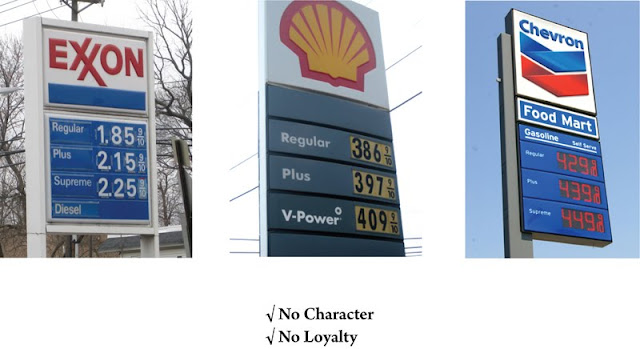The reason loyalty is so scarce is that most marketers don’t understand what truly fuels it. Most marketers are so concerned with communication the virtues of their products and services, they simply don’t think about loyalty as something they can pursue. My experience is that you can encourage loyalty and I have a clear sense of how to do it.
There is a distinction I refer to as character. Character drives and extends business yet I rarely find marketers aware of its existence let alone its value or its origin. One reason is that I am the only person that I know of who has distinguished its existence. Character is difficult to comprehend and even more difficult to explain. Nonetheless, character is very real and there is a big marketing advantage in understanding it. It is solely responsible for target consumers becoming loyal to your selling proposition. Little character produces little loyalty. Conversely, lots of character produces lots of loyalty.
My definition of character is “anything physical, copy or graphic in its form that target consumers will develop a relatedness to. In this regard, generic is the opposite of character. Character stimulates interest on the part of target consumers while generic typically does not. It is best understood by example so I will provide several.
Let’s look at the Go-Gurt package below to get started. It’s a good one because it uses all three of the forms I mention earlier. Try to imagine the first day it was introduced. Remember its just yogurt that they wanted to sell to kids. The same yogurt they were selling to moms.
The Yoplait marketers added physical character to the delivery system when they put it into tubes. They added graphic character with the edgy looking kid depicted on the skateboard. They added copy character when they named it “Go-Gurt” and defined it as “portable yogurt”.
In the late 70’s the supermarkets of the world answered with “plain wrap”. Plain wrap was packaging printed in one color. The inference was that it could be priced significantly lower if it did not use sophisticated printing. Take a look at the Ralph’s plain wrap and you will see a total lack of character. The plain wrap movement was an abject failure. First of all, it did not actually generate a particularly large reduction in the cost of goods. The supermarkets had to price it low to fulfill their promise and therefore made little or no profit. Target consumers soon characterized its user as a cheep or poor person.
Notice that plain wrap did not make a comeback in the recent recession. In fact, all supermarket chains have boosted their private label brands in ways to have them match that of the well known brands. Take a close look at the Van de Kamp’s bakery packaging below. Van de Kamp’s was a family owned bakery on the west coast that folded in the early 90’s. What you are looking at is more Ralph’s private label. The name was purchased by Ralph’s in the late 90’s.
Now can you see the correlation I referred to earlier between lack of character and loyalty in the plain wrap with that of the presence of character and loyalty for Van de Kamp’s. Can you imaging developing loyalty to plain wrap? The punch line.
Character is effective on two levels. The first is that it causes initial interest in the selling proposition. What marketer wouldn’t want that? The second is that of loyalty.
If you have a lack of character, target consumers base their purchase decisions on price or location. Products like gas and services like laundries are notoriously devoid of character yet they have the most to gain by injecting some into their selling propositions. Isn’t it ironic that gas stations are federally mandated to post their gas prices prominently? I have a friend who owns a dry cleaners and I choose to patronize one that is more conveniently located. Maybe, with a little more character, I would.
Below are three brands to consider when evaluating character. Ben & Jerry’s, Starbucks and Newman’s Own are all three great examples of the presence of character and you can see that loyalty follows.
The learning here is of course to look for ways to add character to your selling proposition. The bonus here is that you benefit in two significant ways. Both are responsible for driving business forward.
Cheers,
Keith Chambers
Keynote Marketing Speaker
Creative Marketing Consultant
(310) 473-0010
www.chambersgroup.com
follow my blog by clicking one of the links below



Cheers,
Keith Chambers
Keynote Marketing Speaker
Creative Marketing Consultant
(310) 473-0010
www.chambersgroup.com
follow my blog by clicking one of the links below





